 Vastrik
Vastrik

In other languages: Russian
So, you want to bring a little more cyberpunk to your life. The light should lead your way when you're sneakin' to piss at night; a coffee machine should start automagically with morning alarm. Smart Нome, Internet of Things or whatever they call teapots with microcontrollers this year. I call it "Dumbass Home" because it simply fits better.
I recently moved to a new apartment, and it was a sign to get mad at home automation. If I'm going to buy new bulbs, why not to buy the smart ones? I Googled and got HomeKit, and Alexa, and Philips Hue, and the whole bucket of microchips from Xiaomi. Oh. Nobody said that for a smart home you also need to be smart.
Since I've already spent part of my life for it, I want to tell you about modern IoT. How it works, how start automating your dumb sockets, and how fast Russians will hack you.
Let's start with the main question.
Five years ago, any hacker-kid from your neighborhood could explain to you that any home automation should be done using only wired connections, industrial relays, and using at least five backup channels like the Boeing 747.
So while they were breaking walls in the whole house, technologies took a step forward, and wireless solutions became a standard. Not only because no one wants to drill their walls, especially in rented apartments, but also because they give you complete freedom in the following things:
Of course, wireless gadgets have disadvantages. The main one is that you need to change all the batteries yearly. Can be tricky if you have like 34 gadgets at home, even though they can notify you when they need it.
The second problem you need to solve — wireless protocol pushes you to think about security and encryption continuously.
Remember, S in IoT stands for Security.
You cannot blindly rely on green HTTPS icon, that's not a browser. You need to understand basic security principles and think about them every day.

In Home Automation Zoo everything changes so swiftly that even Reddit articles from 2013 look like prehistoric man's legacy. Three magic words to remember today: Wi-Fi, ZigBee, Z-Wave.
Even there were doubts a couple of years ago, now everything is clear. These three survived, and other ones are dead, oh well, don't care. So if anyone's bringing up X10, OneWire or Lutron Connect, chase that dinosaur away back to the cave. With a pee rag. No one uses them in home automation. Today, they are only useful at factories or the car industry, but that's an entirely different story.
Bluetooth stands apart. It seems to be hyper-popular, but in home automation, it's like a brake light for the rabbit. Unnecessary. A typical Dumbass Home is a technology zoo. Fifteen radio channels get miraculously coexisting here, but that freaking Bluetooth-Xiaomi-Kettle is not. Never. Fuck it. Let's wait until it burns and buy something else. You can't even hack or crack it!
Good news, though — all the shit has such a low entry threshold that you can start at any point you want. Don't have money to buy a hub? Just steal some Wi-Fi bulbs at the nearest supermarket (e.g., Xiaomi Yeelight), connect them with a fancy app and voila, you live in a Dumbass Home. Enjoying it? Go find a used hub on your local eBay, add everything to your Home Kit, and you can scare your cat while hundreds of kilometers away from home. Home automation is fun!

No, these are not those rappers your nephew is listening to.
At the beginning of the '00s, it became clear that home automation is coming. Means, it's somehow irrational to set a Wi-Fi router into every light bulb. So ZigBee and Z-Wave appeared. Both are super-cheap ($1 per chip), energy efficient, and mostly looks the same for the consumer. The only difference is licensing and frequencies, but even geeks don't give a shit about it.
Importantly, they both have features specifically for IoT-zoo. They can create a decentralized network between devices for example — no need to think again in which room to set up an access point to get decent coverage. ZigBee and Z-Wave devices can transmit signals to each other (but not all of them, only those that always connected to a power line, like sockets). Now you live not only in a cyberpunk but also in a blockchain. Fancy. Fashionable. Enjoy.
In short, choose either of these two or use both, if you know how to. I chose ZigBee for one reason: European manufacturers such are IKEA, Bosch, Phillips, and Siemens make everything on ZigBee. All the shelves at shopping centers overflowed with this shit. When I'm sad, I go to the nearest supermarket, pick up a basket of fresh gadgets and back home to fulfill my life again.
By the way, China manufacturers now also use ZigBee more often.
Z-Wave, however, is more popular in the United States. That's why there are so many Z-Wave gadgets on Kickstarter. If you live in the US, Z-Wave is the best choice, probably. Depends. In Russia or India, where cheap Chinese devices rule the party, it's opposite. Explore the local market before purchasing.
ZigBee and Z-Wave have one significant disadvantage. Or had. The early gadget manufacturers are bastards who came up with a “brilliant” idea: let's ban our devices from communicating with other manufacturers. So when you buy a Phillips smart bulb, you have to buy Phillips for the rest of your life. Although they work on the same protocol, it's simply banned on a software level.
Even under the pressure of angry consumers they just yelled to their faces something like "that's for your safety! Russians hack you!" and so on. Nowadays, they behave more liberal. IKEA, for example, fully supports Phillips bulbs. It's more like an exception, though. So if you want to use gadgets from different manufacturers, you still need to think about it in advance. We'll talk more about it further.
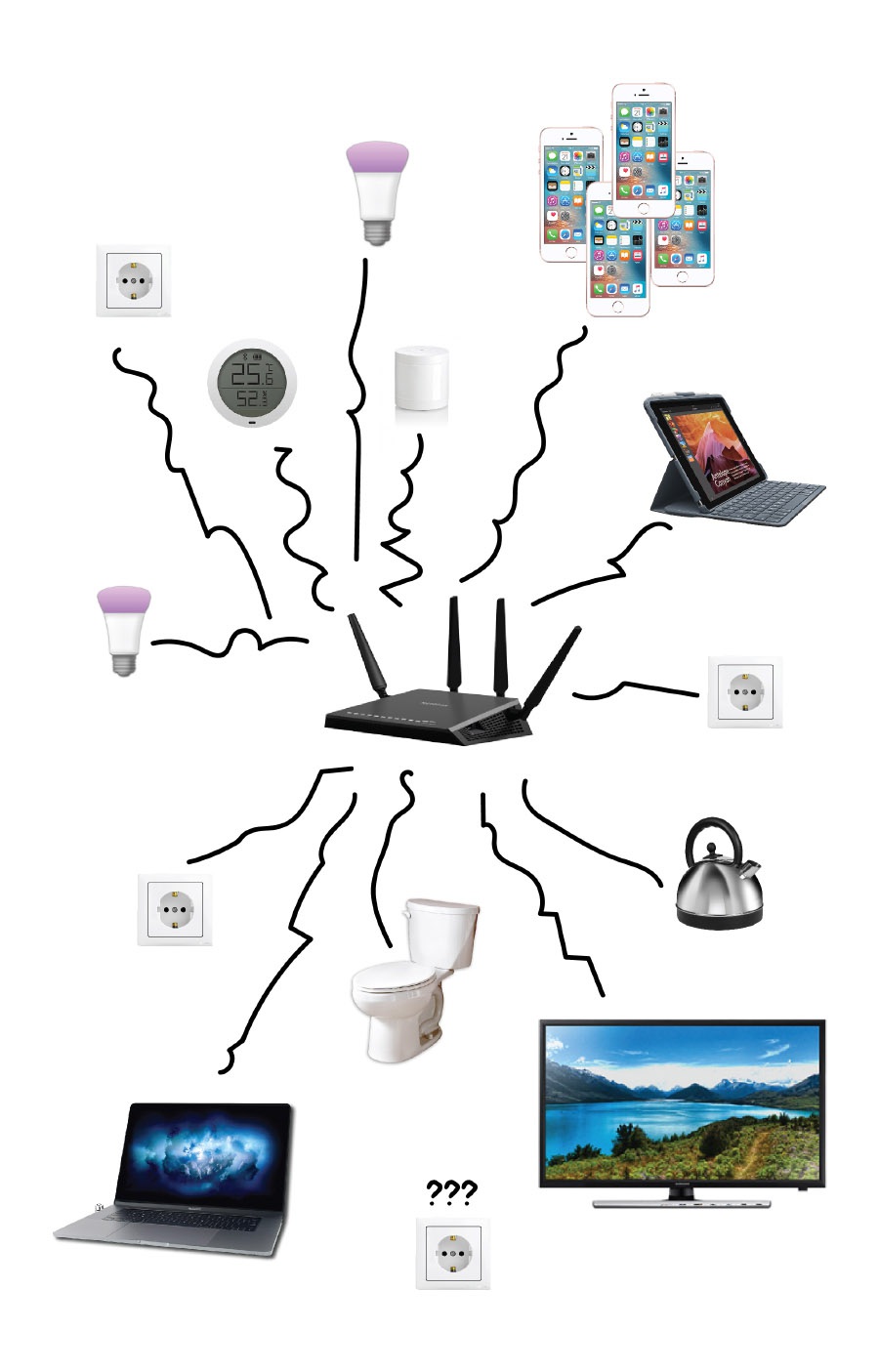
Wi-Fi has one main advantage — it is on every smartphone. Apple and Google are not really planning to insert ZigBee chips to their devices, so that's just easier for manufacturers to set Wi-Fi into their sockets and bulbs than to convince people to use a hub (which is overpriced shit).
Turned out that devices with the most inappropriate protocol are in highest demand. People are so used to Wi-Fi, that future versions will just include ZigBee itself and call it something like “amazing smart home compatibilities,” I suppose. Moreover, these protocols are very similar.
Wi-Fi has a lot of disadvantages: your router is overwhelmed by the number of devices, the coverage at the far corner of your apartment is shitty, it interferes with your microwave and lagging permanently, and the price tag is three-five times higher than at ZigBee analogs.
But it's popular, and we have to live with this. I have no other planet for you now. Ask Elon.
From the other side, Wi-Fi is the first bastion of universality in the entire IoT history. Even my dead grandma can buy a light bulb and a motion sensor at the nearest electronics booth, connect them to HomeKit on her iPad Pro and here comes the Dumbass Home!
The entry threshold is literally zero.
It's good to know the protocols, but we still need to solve real-world problems. We need to program the light strip at the balcony, so it turns on after sunset, or to dim lights when watching movies. Applications would help! Right?
Wrong. Mobile applications are the cancer of the modern era. They are stupid, helpless, and their only goal is to drag you into the ecosystem of a particular brand and force you to buy more shit with a proper logo. That's also true in IoT.
Xiaomi Mi Home, Samsung SmartThings, Bosch Smart Home, even IKEA has their own application today. On the Internet, there are websites entirely devoted to launches and falls of “promising IoT startups”. With daily updates! :D Feel free to jump in there if you have too much free time.
When I was inventing my #dumbasshome, one of my main requirements was independence from any manufacturer. I want to use any gadget I want. I'm tired of cloud ecosystems and subscriptions for for the price of just two cups of coffee. Enough for me.
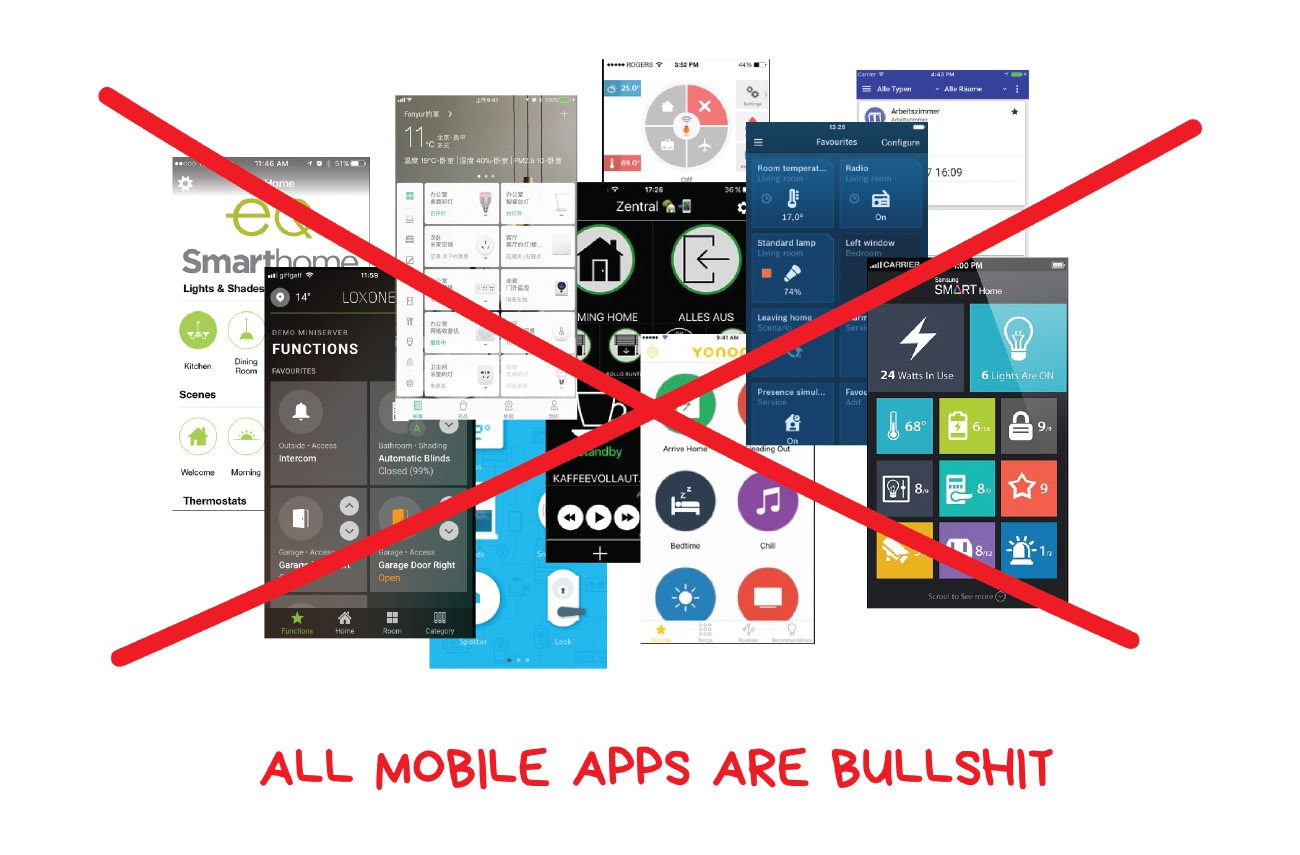
Device Connection Usually done by long-pressing a button at the device while application scans the network. For Wi-Fi devices, you also need to connect to a special SSID and provide your network's password. For increasing security, I recommend enabling guest network for these devices on your router.
The most secure way is the one that HomeKit use — you need to scan a bar or QR-code printed on a device or its box with an app, to set up an end-to-end encryption key pair. The real fun starts when you lose these codes :D
Triggers Events which can run automation. Usually, the more triggers, the better. Your phone already knows a lot about you: areas where you live and work, your local weather, types of transport you use; even taking a photo can be a trigger.
IFTTT will dramatically help here.
Here, the richest level is the ability to create conditions from triggers using OR and AND operators. E.g., IF motion detected AND the sun is below the horizon THEN turn on lights.
Automations Actual scripts which you can run with triggers or manually pressing a button. Here, I like Alexa's approach more — you can download skills and create a scenario of them — turn on coffee, run my morning playlist, kill all humans oh wait... I didn't add the last one.
Groups Aka rooms or areas. One day, there will be more than ten devices at your home. That usually happens in a month after buying a first one. Therefore, you will probably need to group and control them all together.
The most useful group is, in fact, "All Lights" which allows you to easily turn everything off when leaving.
Scenes My favorite scenes are "watching movies," "evening blogging," and "going to bed". The idea is to save the settings of several gadgets, like, the colors and brightness of lamps, heating controller position, etc., to reproduce them in the future.
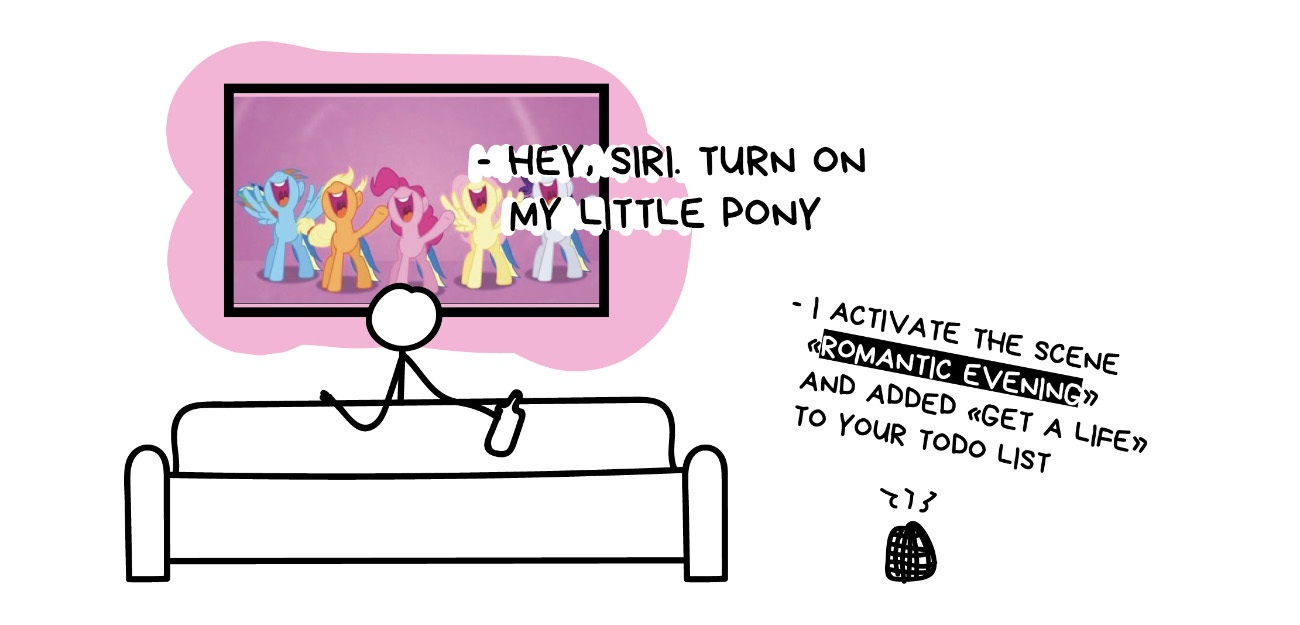
Being a trendy solution, HomeKit is honestly not so bad in comparison with others and even can be useful in DIY as a fancy remote controller.
Technically, HomeKit is an SDK which includes a lot of things.
For an ordinary customer, HomeKit is an app for iPhone, iPad, Apple TV or HomePod that communicates with devices using standard Wi-Fi via a secure HTTPS channel. Inside, it has a database that you can safely share with friends and guests and an ability to add new devices by scanning QR-code from the box to create a key pair for encryption, as I mentioned above.
Ten RSA out of ten, in short. I wish to go back for 70 years ago and show Alan Turing that we now we have end-to-end encryption in every fucking light bulb!
Top HomeKit feature for me — it makes full use of your existing infrastructure. I didn't even realize it uses my Apple TV as hub when I'm not at home. I thought it's impossible to communicate with my home devices from the outside since public IP-addresses in Germany is a business-only feature (which is complete dipshit). But no, HomeKit uses standard push notifications you have on your phone and avoid all the networking problems.

However, there are two disadvantages. First, HomeKit always means Wi-Fi — there are no other implementations. It means all fifty smart bulbs will mercilessly send HTTP requests all over the house. Not a nice thing even for modern Wi-Fi networks. Maybe the next versions will be better.
Second, any HomeKit-compatible device must be Apple certified. One of the main requirements is to have built-in end-to-end encryption. Complying with Apple guidelines was too expensive for manufacturers while consumers don't care about it. Manufacturers came up with an idea — let's make light bulbs using low-cost radio protocols like ZigBee and Z-Wave, but adding a special layer for communication with HomeKit. They called hubs.
It's a box the size of a pack of cigarettes that converts the signals from your lights and sockets to smartphone-friendly Wi-Fi. And sells your data, of course. Mostly.
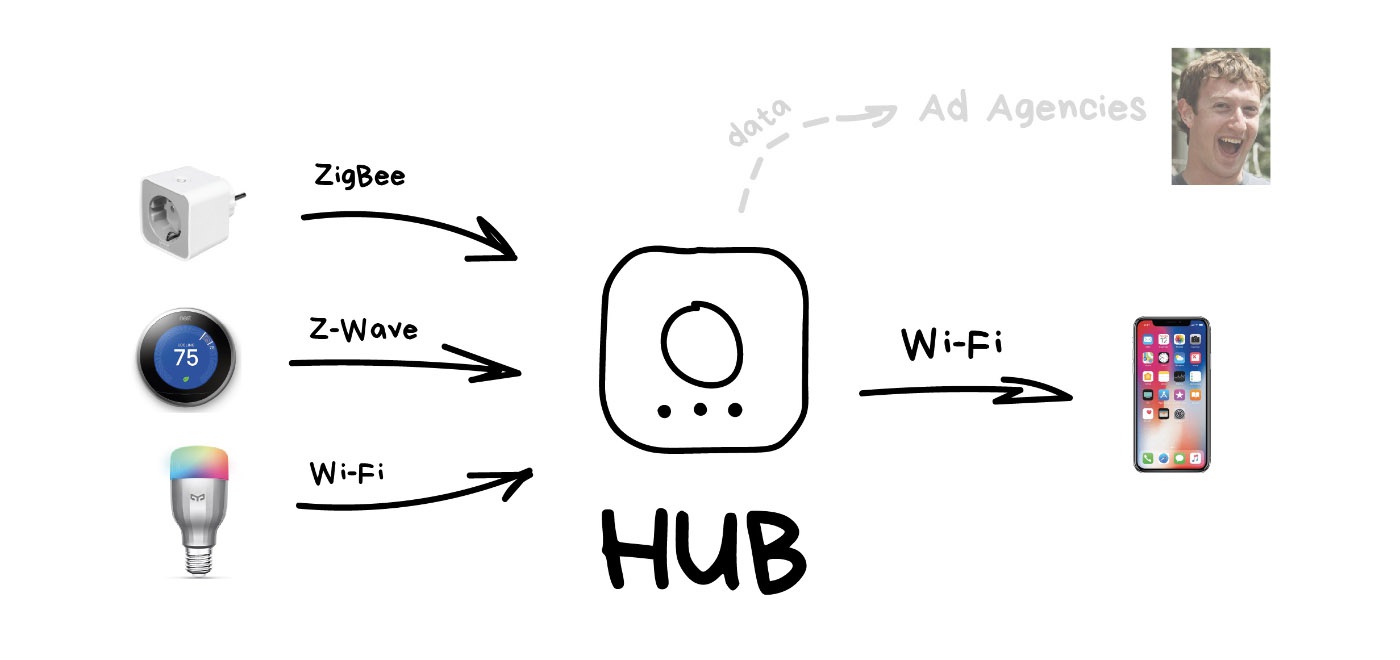
Hub allows you to control ZigBee and other unknown-protocol devices with your smartphone. The idea behind is that you can pay $30-40 for a hub once and use cheap ZigBee devices for $15-20 instead of paying $40 for each Wi-Fi light bulb. It works in an ideal world and pays off with a second or third gadget. In reality, the invisible hand of capitalism comes into the game, dividing all the hubs into three categories.
Every toilet seat manufacturer today makes a hub that works exclusively with their toilet seats. There're millions of them in any electronics store. And there's no difference between them, but you still have to buy them separately for each manufacturer. Someday they all die, as open standards always beat vendor-locked nonsense.
Despite vendor-fencing, branded hubs are useful if you want to buy, plug-in and enjoy without any brain activity. Go for it! But be careful, as they will occupy all the sockets in your house soon.
For most sane people though, branded hubs is a good start. They also come with a cute app sometimes. Phillips Hue, for example, which allows you to create a fake-ambilight effect or change color to the music beat.
The main disadvantage is that they all require Internet access and works only through their fucking cloud. My little geeky soul is utterly protests because wait, I can buy a Raspberry Pi for the same $30 and spend some wonderful nights trying to build buggy OpenSource libraries from GitHub. Seems like a good deal!
F is for Fun!

Links:
They came to save us from brands with two-cups-of-coffee clouds and fenced infrastructure. With the support of five protocols at once, from Wi-Fi to Bluetooth, and a fun community of geeks as an addition, they looked like a good deal.
But... something went wrong.
At the beginning of the decade, several Kickstarter projects run with this idea. SmartThings Hub was one of them. It raised $1.2 million from bakers and got $3 million and $12.5 million from investors.
It was such a victorious feeling.
Until Samsung bought them in 2014 for $200 million to made a new toy. Seems like they just wanted some cool name to sell with new TVs and refrigerators, rather than develop and maintain real IoT stuff. The community has mostly done all the work. And still, one favorite entertainment for SmartThings users today is to come home in complete darkness because Samsung clouds are down again.
Hype-train turned to smart speakers and assistants, as the market did not accept any new players. Today, new hubs appear monthly, but I don't see a single decent one. In a year, they will all go bankrupt and shut down, because whoa, who would guess it?
If you're feeling adventurous but not as much to write python scripts, then why not. Newest SmartThings Hub is still a good choice for geeks who have a life.
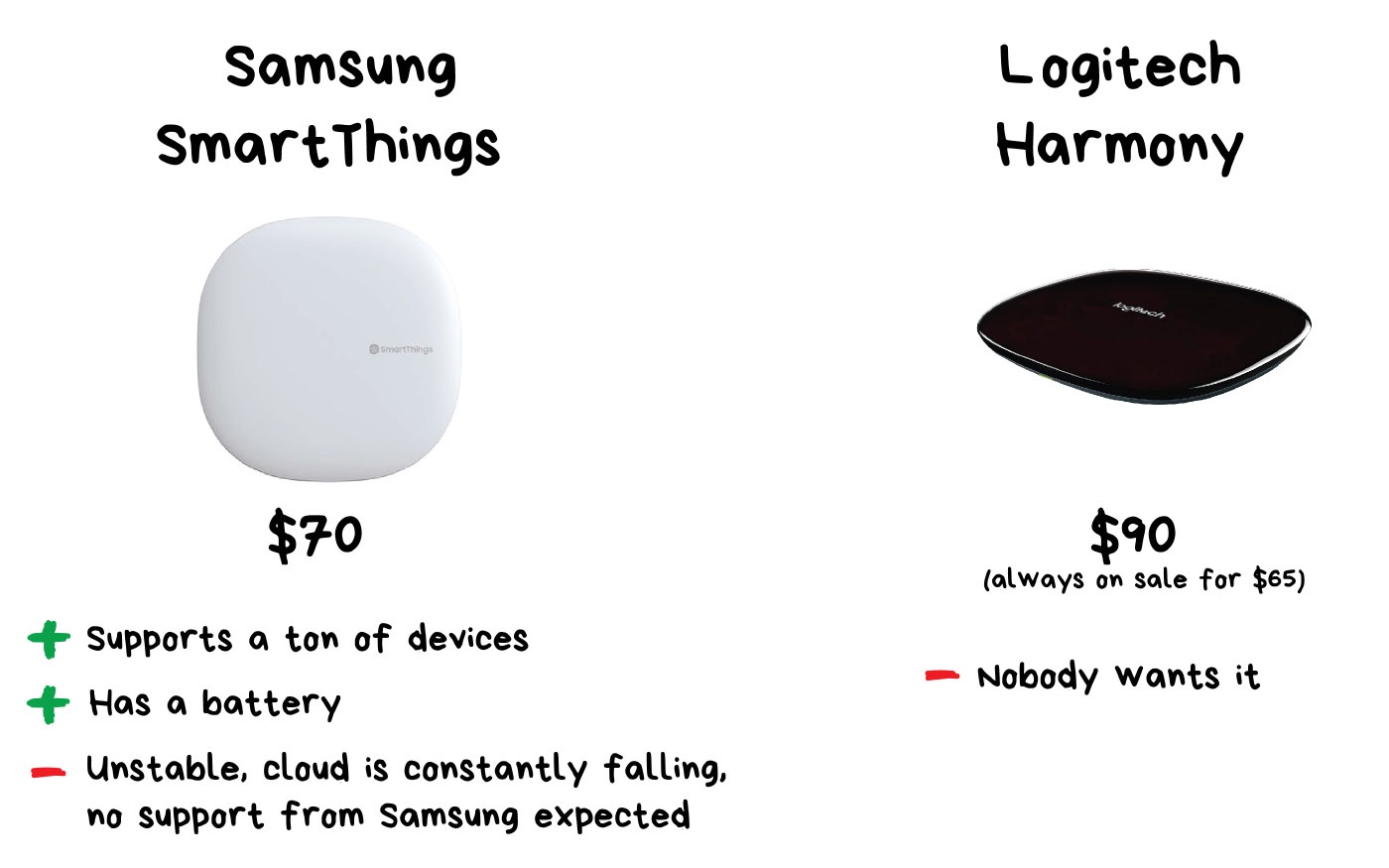
Links:
Basically everything you can build with your drunk friends on a Raspberry Pi in the garage. DIY solutions today are trivial as a bicycle — making your own IoT hub is easier than running a pirated game from torrents. Download an image to your SD-card, plug it in — profit, you are hackerman.
Raw Raspberry Pi without any additional modules allows you to control Wi-Fi and Bluetooth devices and connect gadgets of different vendors. It also gives you some nice features such are weather forecast, presence detection using NMAP and MAC-addresses of phones connected to your Wi-Fi, and the ability to connect all these guys to HomeKit. Even unsupported ones, yep.
Then you can go to Amazon to get some modules for ZigBee or Z-Wave (these are the models I checked myself). Now you have the entire zoo of Xiaomi, Phillips, IKEA, or whatever, supported right out of the box. I connected IKEA light bulbs to OSRAM switches and Xiaomi sensors without any problems using RaspBee.

Feature-wise, DIY-hubs are all about the same: generic "material design" web interface, buggy integrations with external services using unofficial python libs, and scriptkiddy-style dashboards, which can be displayed on your old iPad somewhere near entryway, as I did in Dumbass Home 1.0 (warning — scary Russian letters!).
Some ideas are a pure copy of our shitty python scripts from 2012. Like geolocation tracking using my own iPhone with "Find my Phone". Lovely world of hacks! Also, with incredible (((stability))). Because what can go wrong?
Nothing has changed over the years, by the way. Only some fancy new buzzwords were made for it.


Links:
For those who somehow care about my opinion — I've chosen Home Assistant. It's modern but stable and written on Python. As expected, everything is good at the beginning but when you actually want to do something useful, there comes the pain, suffering, programming. I don't ask much, but when their unique cloud, which you need to pay for, just throws an error on authorization, the unforgettable taste of open-source appears in my mouth again.
I love technology!
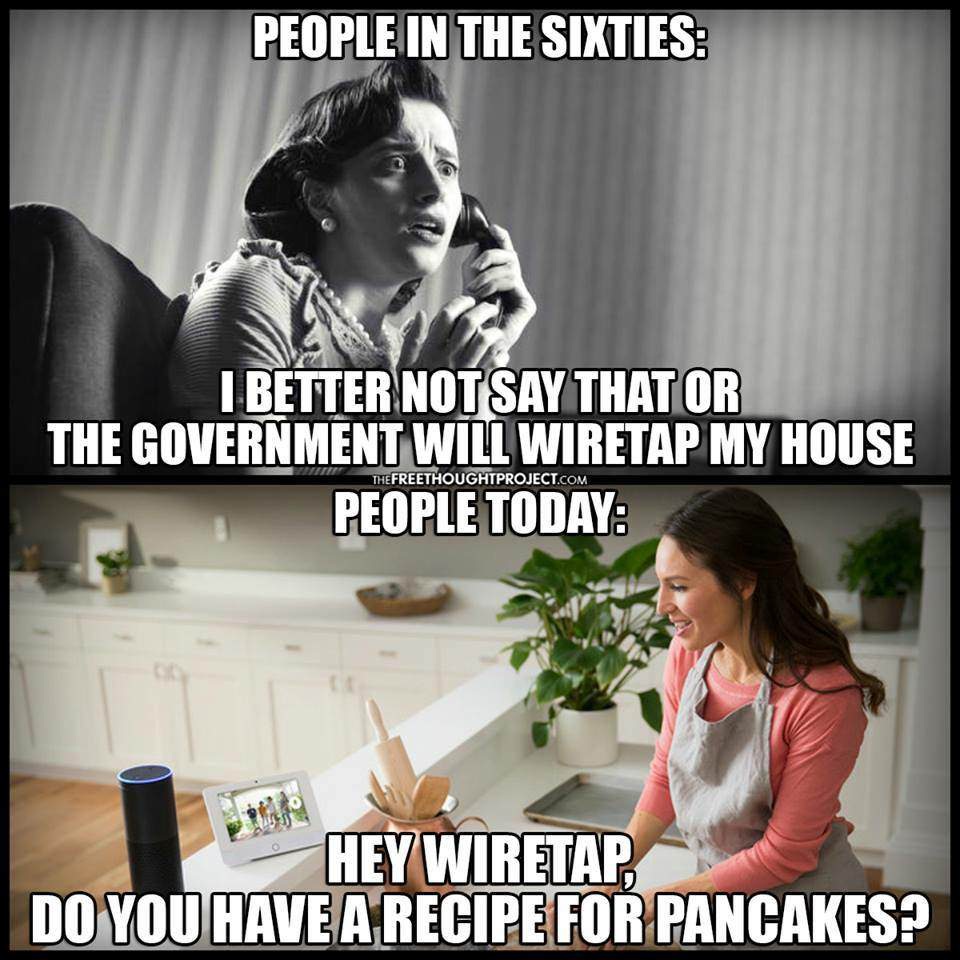
From my technofascist point of view, there is no place for them in this review, but we must give them credit — they brought the most standardization to this zoo. If you are too lazy to think just take one of these guys and build your Dumbass Home using devices with the “Works with...” icon. It will definitely work.
Today there are three main players at the market — Amazon Echo with Alexa, Google Home with Google Assistant, and Apple HomePod with stupid Siri. All three can somehow answer your questions and run some automation. That's pretty all "smart home" features that journalists love to shout about in every TechCrunch article.
Technically, a smart assistant is a pair of poor-to-medium quality speakers (but no one notices it because of high sound compression), a bunch of directional microphones, and hardware from low-end Chinese smartphone. Inside, there is a simple ML-model for speech recognition, after passing it everything goes through the cloud. Communication with external devices only done via Wi-Fi, so there are no cheap bulbs for you. There's only one exception — Amazon Echo Plus, which supports ZigBee. Though it costs 50 bucks more, it's unpopular, and only adds even more confusion to the whole story.
I wrote the main pros and cons of dumb assistants in the table below. It's subjective indeed, but to me, it looks useful.

Geeks may consider buying as good voice activator for automation. This is the only thing they do well. The rest is the wet dreams of their sales teams. According to recent polls, 70-80% of users use them only to listen to music. If you really want a useful smart speaker, consider paying more for Google Home Max or Apple HomePod. Other speakers are too bad for music.
I actively tested all three and stopped at Alexa, the cheapest. I already have a good sound system at home and see no reason to pay more than 30 bucks for a voice-activated button. Even a piece of stone is more useful for me at home.
However, even my hater-heart melted when I first asked Siri to turn off the light while lying in bed. Of course, Siri understood me only on fifth time, and I looked like an idiot, but the feeling was genuinely cyberpunkish.

Any technological DIT eventually comes to purchasing more shit with microcontrollers. Well, it's time. I tested a huge pile of different devices from eBay, Amazon, and Aliexpress, and divided them into categories.
I sincerely hope someday such blocks will become unnecessary but on the modern Internet, if you don’t write explicitly “don’t put your cat into the microwave,” someone will surely try and blame you in comments. Therefore:

I'm not talking about NoName webcams. If you want one, just find one for free on websites like shodan.io. Yet, a couple of years ago, more interesting Chinese companies began to enter the market. Such are Xiaomi or Sonoff.
Their gadgets have two advantages: ridiculously low price and a pretty good look. They are even better live than in photos — small, white, matte. It's something like classic Apple products. It's even beautiful to throw them at the wall when they don't work.
When buying, always pay attention to the protocols. They are pretty standard, but always different, and that's how a zoo starts. Xiaomi lamps work on Wi-Fi, Sonoff-relays too but uses MQTT (with Sonoff-Tasmota firmware), sensors are running on ZigBee, Kettle is on Bluetooth. How does it work with each other? That's right — in no way. That is your job.
Also, get ready for classic Chinese jokes. The Xiaomi Kettle, which cannot be turned on or off remotely. Or the hub, which asks to press a button at each device to re-activate them after a new software update. All 56 of them! Or a motion sensor that doesn't work well in the dark — which is particularly ironic.
As always, want cheaper — get used to suffering.
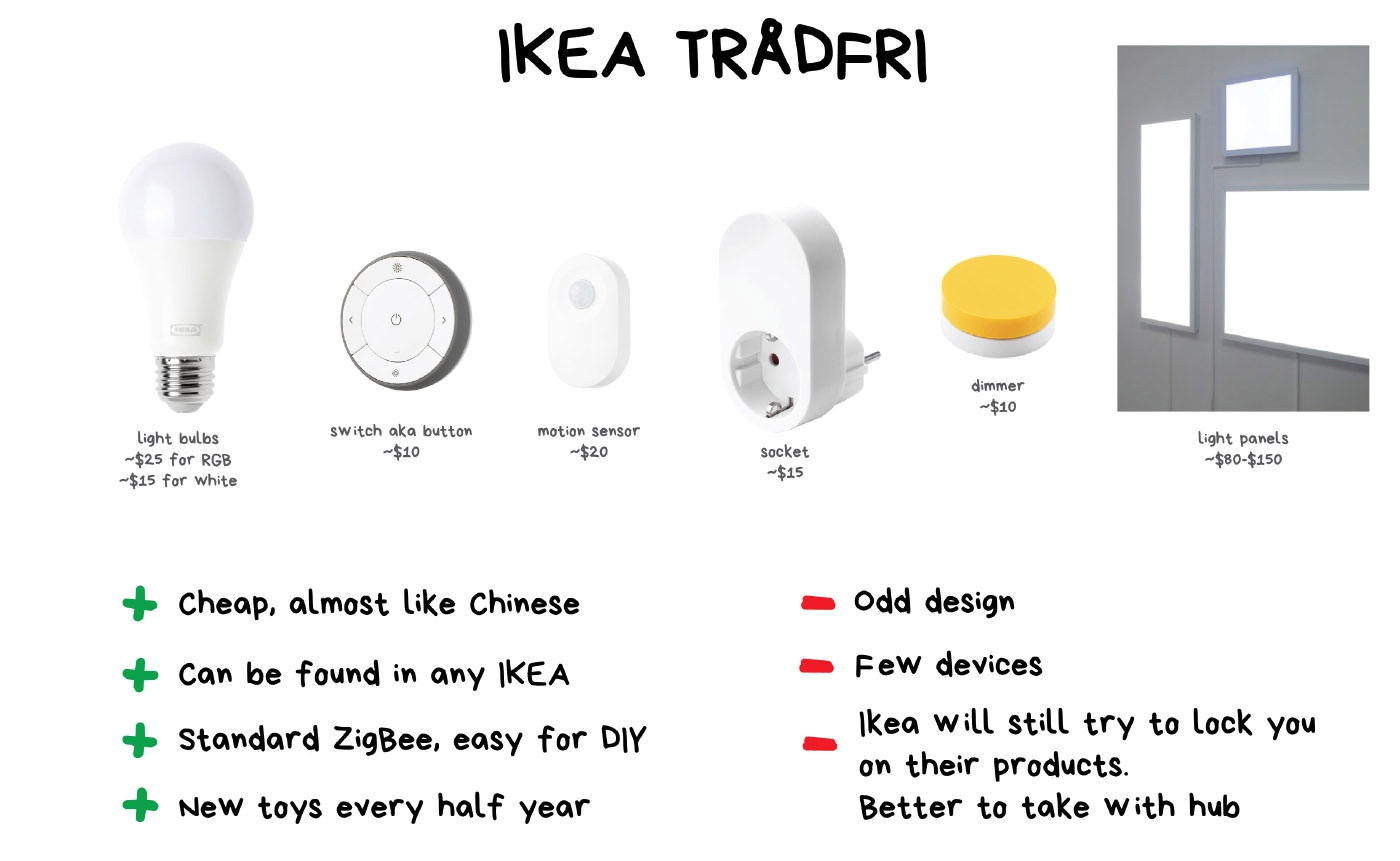
Last year, IKEA also launched its line of smart devices. These Swedes made their gadgets on the purest ZigBee, so they even work with some other manufacturers like Phillips. They brought it to every corner of Europe and the States — such coverage and standardization are extremely rare for IoT manufacturers.
The price tag is only slightly higher than Chinese gadgets, but there is a brand reputation at stake. Always good to have someone to update and be responsible for these toys, if they also decide to organize a botnet.
The main disadvantage is a terrible design, but it's subjective. Although, I like that lovely round dimmer with buttons, already bought six of them. Buttons are never enough!
In general, I can recommend it. Better with the hub, then there will be fewer problems. They are planning to actively expand the line-up (a new outlet came out last month), and a whole community of fans has already gathered on Reddit. There is hope.
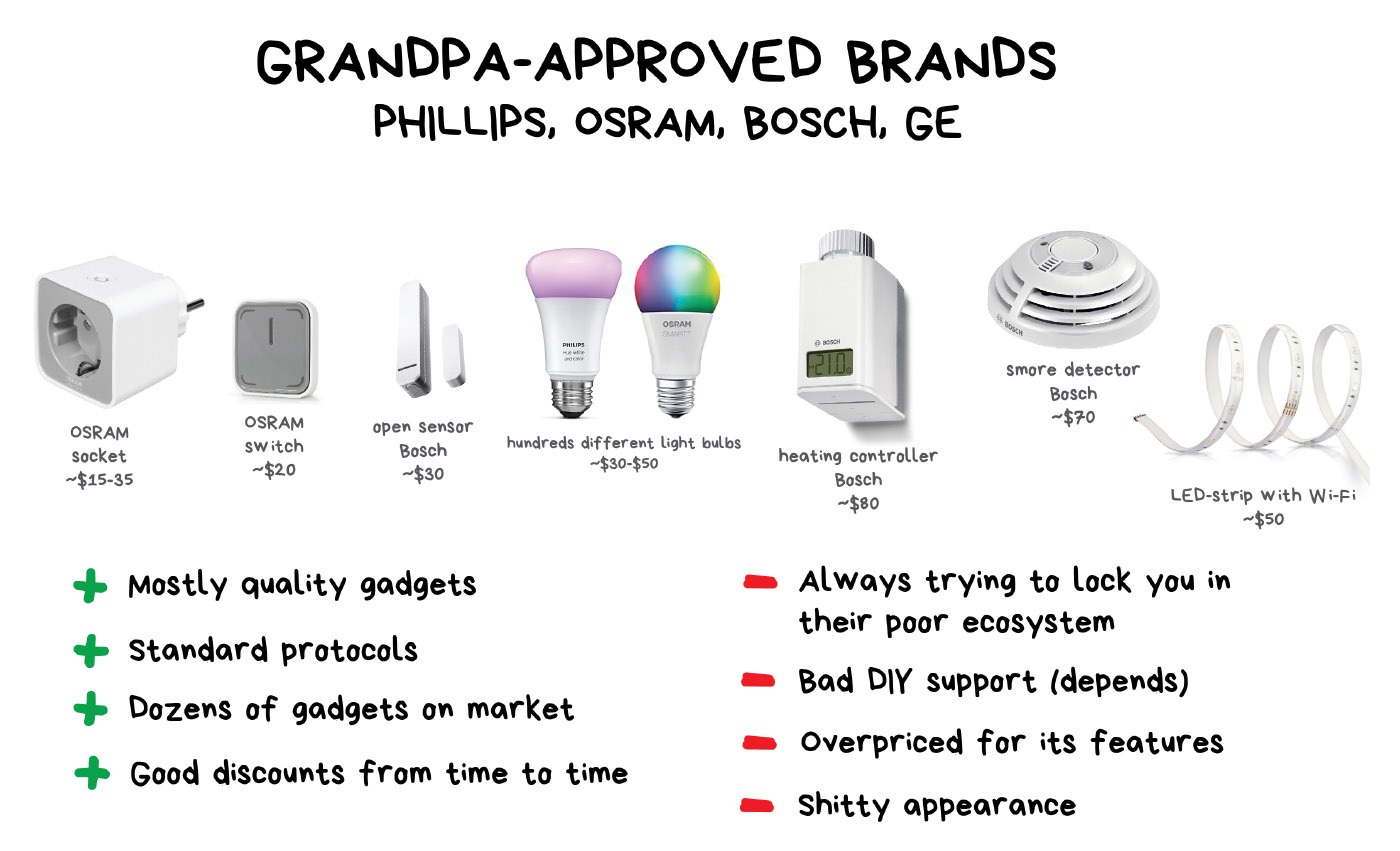
Manufacturers, whose sockets are still your grandfather's favorite, rushed into the IoT too. With no confusion, they've started to put radio channels into everything. The technical design was made by a drunk locksmith, who drew three rounded squares at MS Paint and printed it out. They can be found in any electronics store, unreasonably overpriced.
The advantage of all these bosch-lebaro-siemens is their reliability. Like soldier boots or Soviet armored train, they'll outlast all of us and will still blink in the wreckage of our homes. Yes, they start to backlash immediately after the purchase, but they live with this backlash for centuries!
When their manufacturers don't try to play "the future" and simply make their common sockets with pure ZigBee inside, they do pretty well job. Their solutions are always easy-hackable and useful.
Also, on any eBay-Craigslist, you can always find a bunch of these at half price. For example, I got three OSRAM sockets for ten bucks just because someone in the Amazon warehouse damaged the boxes. Profit!
Used IoT is even better than new!
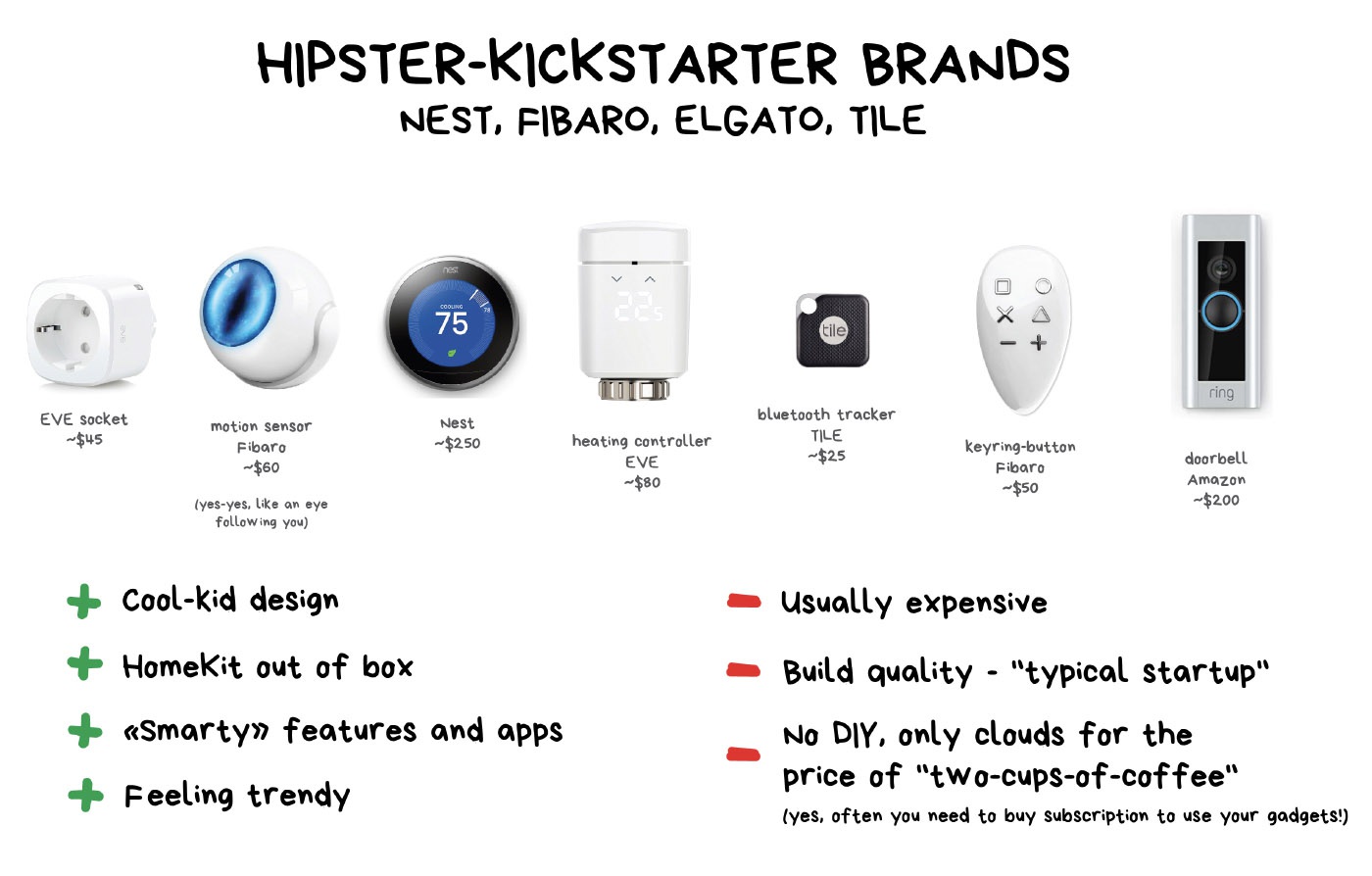
Mostly from the US. Buzzword-brands which flash daily in tech-media. Аfter reading these TechCrunch-articles, everyone wants a Nest thermostat with “artificial intelligence” inside — even those who live in Brazil and have no heating.
Hipster gadgets are usually not that bad. Of course, they have not heard anything about standards. And they do everything through their own cloud on Node.js, which falls from time to time, turning off all the heating in your home. Despite, they make the most exciting features in the IoT world today. A doorbell with facial recognition or an air purifier with an odor detector — everyone wants it, don't lie.
Build quality depends. Some are actually well done, others just look that way, but on average it is ok.
The main disadvantage — they're illegally expensive. One simple light switch can cost more than a whole lamp. You have to fight yourself every time and still buy it because our life is short and we have to try all the shit from Kickstarter!
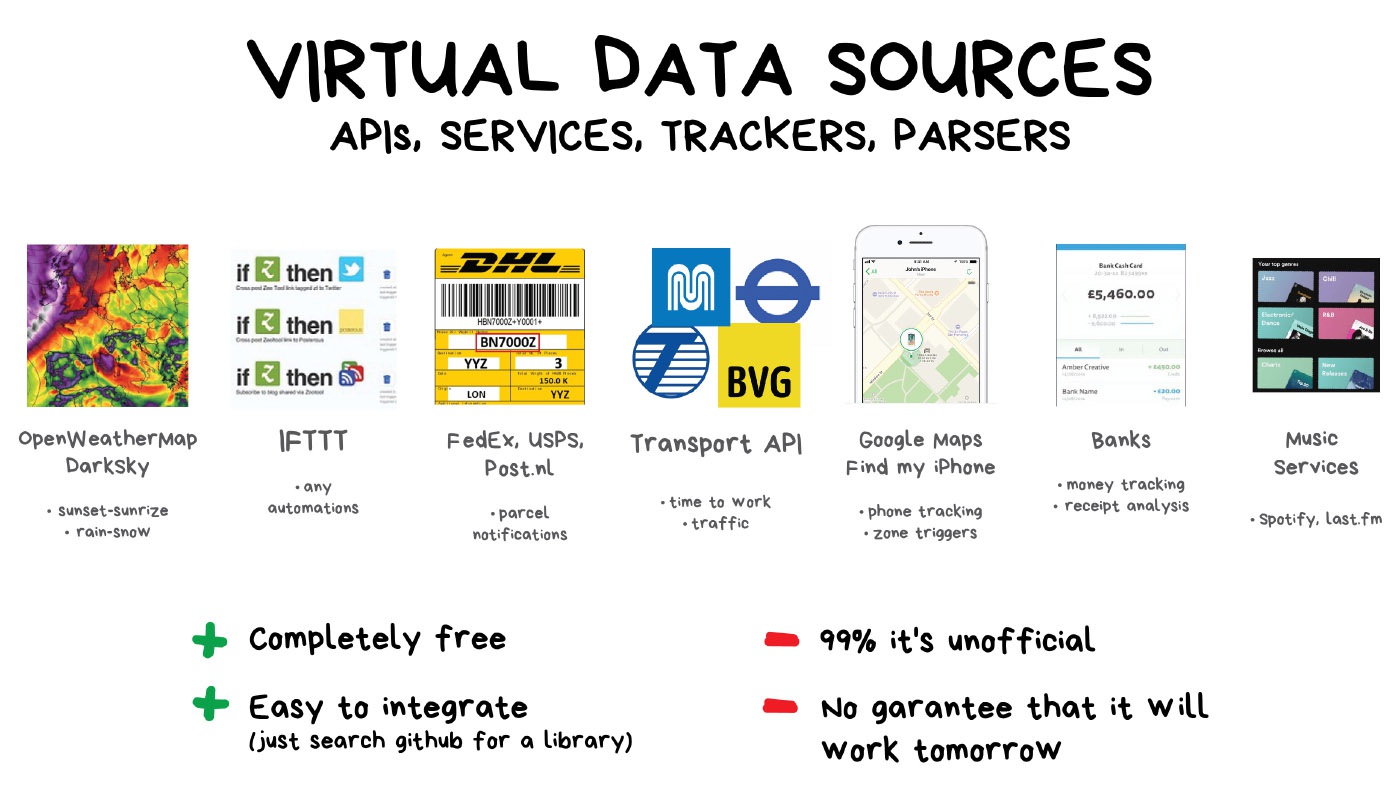
IoT world is mainly hardware-party, and other data sources are often unfairly forgotten.
Back in 2012, when last.fm was a thing, a friend of mine came up with a killer feature: when someone came to his home and connected to Wi-Fi, his home server using the MAC address determined the guest account on last.fm and started scrolling music that played on the speakers at that moment. Truly fantastic. No more "where could I heard this sound" questions.
Good old times with google-woman announcing loudly and crappy "WELCOME TO SMART HOME, VAS-THREE-KEY".
I remember I wanted to make a recommender machine based on the common interests of all guests. The system should automatically analyze their accounts on YouTube, Spotify, Netflix to create a playlist with a selection of videos and music for the common interests of all who are in the apartment at this time. YouTube parties are so fun and enjoyable, but not everyone wants to watch Drake clips. Please, steal this idea.
If anyone has any other ideas on how to use various APIs for home big-data, please comment below.
Now, in my new flat, only bare walls and a toilet are waiting for me. It's normal here in Germany to rent an empty box even without light bulbs. Two wires are hanging from the ceiling. Go, do what you want. Say thanks previous tenants did not take the flooring — also happens. It's the first time in my experience and seems a bit wild, but it gives you the opportunity to do everything from scratch!
I plan to settle down here the next few months, so let's dream a little. How I see the ideal #dumbasshome that can be already implemented in modern technologies. Some things will take thousands of man-hours, maybe, but that is what dreams are for.
Take my ideas and share yours so others can steal them too. This is how the Internet should work.

Luckily, I'm not Elon Musk and don't need to get up at 5 AM every day. I don't use an alarm, but I need half an hour with my phone to stop hating the whole world and go to the shower. I definitely want a system that will say — "hey, don't send this angry message, probably it will ruin your relationship". But let's back to the story.
“Good Morning, dumbass home” command activates the morning script — coffee machine turns on, and home tells me a brief for the day — my weather, calendar. Then, Spotify Weekly Discovery playlist starts playing from the bathroom speaker.
News selection from an RSS can be a killer-feature here. There I subscribed to the most important things that form my information field.
Like this, for example: today in the news: everyone is discussing the fall of Bitcoin, a new meme about parrots is in trending, a dickpick scandal has started around Jeff Bezos. From your subscriptions: new post at «Wait but Why» — take a look. Will add it to your reading list. 134 new articles on Wired and TechCrunch about Artificial Intelligence defeating someone in something again. Will automatically mark them as trash. Have a nice day.
Huh. If Prismatic were alive today, maybe it would have reached that level.

The first #dumbasshome began with an old 1st gen iPad hanging on the wall. It displayed a to-do list, traffic and the balance of my student subway ticket. The golden years are gone, but the idea of an information screen still excites me. Only the use cases have changed, the country has changed and now the support of several users is needed.
The tablet or screen should hang at the entryway, as it comes in most often there. It should only show the essentials: a clock, music management, shopping list, upcoming events from the family calendar, driving time to work and the recommended transportation — bicycle, metro, tram, or fuck it stay home.
In a separate tab, you can manage any gadget in the house — in fact, the admin panel. Like any device, the screen is a simple client inside my local network; turning it off does not affect anything. It works day and night, so it shouldn't eat a lot of electricity and burn eyes in the dark. Both problems can be solved with OLED display and the black interface, but these are implementation details. OLED's are still quite expensive.
My primary goal is maximum utility from a minimum set of functions. If it merely shows traffic jams and the weather, this is already more useful than 80% of ready-made solutions for a “smart home”.
Here is how I see the prototype (drew it in five minutes, do not judge me):

The end of the working day, I'm leaving the office. My iPhone sees I left the geo-zone "work" and activates an "on the way" trigger. A list of groceries to buy is sent to my watch as a notification. This list is one for all, it always displayed on the tablet and can be edited from any connected device.
Buying groceries, going home.
Dumbass Home determines I'm nearby and turns on a garland at the balcony, and maybe heating if it's cold. The sensor on the mailbox reminds me to pick up new mail. I can just put the open sensor there because I live above it on the second floor.
At the same time, a sound notification is triggered at home, notifying that someone from the tenants is near. I had this in the last apartment — the intercom squeaked when someone entered the doorway by entering a code (it was different for every apartment) — it was very convenient to meet wife from work and take her bags. Should work absolutely for everyone, even for guests.
I'm entering the flat. If there is nobody inside, the “welcome home” scene is activated. Lights in the hallway and the kitchen turn on (if it's dark), my TV is turned on in the living room, fresh videos on YouTube are playing on Apple TV in an almost silent mode. You can ask #dumbasshome to turn the volume up or send all those YouTube-bloggers to hell and play Spotify compilations.
I arrange purchases on the fridge and scan the receipt. If you live in a country with electronic receipts (like Russia), you can directly download all this information from your supermarket account. If not, you can do it the old way — recognizing the receipt with your phone's camera.
The groceries list is added to so-called "homemade bigdata", where everything is analyzed — from the usefulness of the purchased products to possible discounts on noodles and broccoli in the nearest supermarket. I think there are already startups for this — like "dumpster diving with machine learning". Probably the next unicorn!
Such a list is useful not only to remember what to buy but also to track what you already have. I realized this when I bought the third pack of carrots in a week, thinking it's gone. Also, you can connect some recipe-website API and automatically build dinner proposals from the products you have.
As another killer-feature here, I see tips like "you can increase your list of possible dishes by 15% by buying a pack of eggs in a supermarket". Or even more intense, like, "your fitness bracelet reported you're fat, please exclude these fatty products and eat less KFC". But muuuuum...
Guests must also have a full dumbasshome-experience. It requires user profiles. When Dumbass Home sees a new person connecting to Wi-Fi, it asks basic things like the name, accounts on Netflix, YouTube, last.fm and other useful stuff for my bigdata. Of course, everything is safely stored in super-secure USB flash drive, plugged in Raspberry Pi. GDPR form can also be found under the toilet.
To be serious, everything is completely voluntary.
The system parses the user's media interests to find intersections with other guests. The only music that does not piss off everyone will play by default in the house — same story for YouTube and TV shows.
Regardless of access level, all users in the internal network have access to TV, music and other multimedia with one click from their smartphones. We already live in cyberpunk and lost the habit of running around the computer every time to change playlist in MPD. AirPlay, Chromecast, and receivers with Bluetooth and AptX are already solving this problem quite well.
Besides, Pi Hole installed on my home server cuts ads on all devices that work through home Wi-Fi. Because I hate banners on the Internet. I dream of a similar tool to cut the cookie-popups and privacy policy bullshit.

First scenario: Friday evening. The system downloads a list of events in the city today from local Facebook and finds the best opportunities. Parties with favorite DJs, cool street shows or standups — depending on my mood and interests.
Second one: couch potatoes. The lighting dimmed down; the "being lazy" color scheme is turned on, Plex, Netflix or whatever you use for that is launched. For each movie it's own lighting scheme is downloaded from a special website. Have a nice dumb.
Third: blogging or coding. All notifications are turned off, the lighting becomes as comfortable as possible for work, rhythmic music without words is turned on, everything tries not to annoy me. Probably, noise-canceling headphones are required.
Fourth: party-hard. The problem of the first world: you come home after the Friday beer and want to continue. The scene turns on an approved playlist for on a shuffle and makes the lights blink to the beat. Please, take a smoke machine in the corner.
Tell in the comments what evening schemes do you have.
Healthy sleep is important! Especially when you go to bed at four in the morning. In order not to shout “Alexa, turn off the light” in the middle of the night, the button for switching on the nightlight near the bed has a second purpose — long press activates the “time to sleep” script. Turns off the light, decreases heating, AC maintains the temperature in summer.
But there is the most important thing remains. The one that started it all. An idea, that excites millions and makes them spend thousands of dollars on smart outlets and bulbs, learn the differences between ZigBee and Wi-Fi, and read strange articles on the Internet.
Night illumination for the road to the toilet.
The Samurai Path. The way of Tiger.
Now you have all the necessary knowledge to make and walk it yourself. Good luck, young padawan.
In conclusion, I would like to say that all my posts, including this one, come out solely because of your support. It allows me to keep them independent and unpaid by any of the brands, that is rare today on the Internet. Below there is a form where you can say thank you and support my logreads. Each donate supports my enthusiasm for such experiments. Thank you for reading.